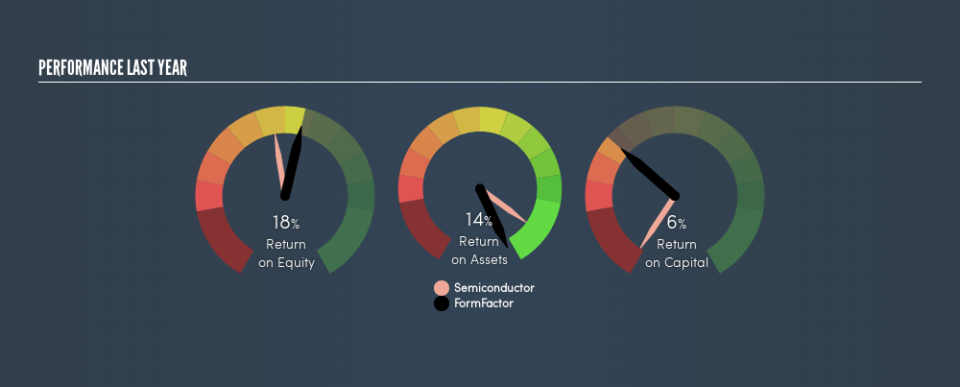Here’s why FormFactor, Inc.’s (NASDAQ:FORM) Returns On Capital Matters So Much

Want to participate in a short research study? Help shape the future of investing tools and you could win a $250 gift card!
Today we'll evaluate FormFactor, Inc. (NASDAQ:FORM) to determine whether it could have potential as an investment idea. To be precise, we'll consider its Return On Capital Employed (ROCE), as that will inform our view of the quality of the business.
Firstly, we'll go over how we calculate ROCE. Then we'll compare its ROCE to similar companies. And finally, we'll look at how its current liabilities are impacting its ROCE.
Understanding Return On Capital Employed (ROCE)
ROCE is a measure of a company's yearly pre-tax profit (its return), relative to the capital employed in the business. Generally speaking a higher ROCE is better. Ultimately, it is a useful but imperfect metric. Author Edwin Whiting says to be careful when comparing the ROCE of different businesses, since 'No two businesses are exactly alike.'
So, How Do We Calculate ROCE?
The formula for calculating the return on capital employed is:
Return on Capital Employed = Earnings Before Interest and Tax (EBIT) ÷ (Total Assets - Current Liabilities)
Or for FormFactor:
0.062 = US$40m ÷ (US$757m - US$101m) (Based on the trailing twelve months to March 2019.)
Therefore, FormFactor has an ROCE of 6.2%.
See our latest analysis for FormFactor
Is FormFactor's ROCE Good?
ROCE can be useful when making comparisons, such as between similar companies. In this analysis, FormFactor's ROCE appears meaningfully below the 12% average reported by the Semiconductor industry. This could be seen as a negative, as it suggests some competitors may be employing their capital more efficiently. Setting aside the industry comparison for now, FormFactor's ROCE is mediocre in absolute terms, considering the risk of investing in stocks versus the safety of a bank account. Readers may find more attractive investment prospects elsewhere.
FormFactor delivered an ROCE of 6.2%, which is better than 3 years ago, as was making losses back then. That implies the business has been improving.
When considering this metric, keep in mind that it is backwards looking, and not necessarily predictive. ROCE can be misleading for companies in cyclical industries, with returns looking impressive during the boom times, but very weak during the busts. ROCE is, after all, simply a snap shot of a single year. Future performance is what matters, and you can see analyst predictions in our free report on analyst forecasts for the company.
What Are Current Liabilities, And How Do They Affect FormFactor's ROCE?
Current liabilities are short term bills and invoices that need to be paid in 12 months or less. The ROCE equation subtracts current liabilities from capital employed, so a company with a lot of current liabilities appears to have less capital employed, and a higher ROCE than otherwise. To counteract this, we check if a company has high current liabilities, relative to its total assets.
FormFactor has total assets of US$757m and current liabilities of US$101m. As a result, its current liabilities are equal to approximately 13% of its total assets. This very reasonable level of current liabilities would not boost the ROCE by much.
What We Can Learn From FormFactor's ROCE
If FormFactor continues to earn an uninspiring ROCE, there may be better places to invest. Of course, you might also be able to find a better stock than FormFactor. So you may wish to see this free collection of other companies that have grown earnings strongly.
I will like FormFactor better if I see some big insider buys. While we wait, check out this free list of growing companies with considerable, recent, insider buying.
We aim to bring you long-term focused research analysis driven by fundamental data. Note that our analysis may not factor in the latest price-sensitive company announcements or qualitative material.
If you spot an error that warrants correction, please contact the editor at editorial-team@simplywallst.com. This article by Simply Wall St is general in nature. It does not constitute a recommendation to buy or sell any stock, and does not take account of your objectives, or your financial situation. Simply Wall St has no position in the stocks mentioned. Thank you for reading.

 Yahoo Finance
Yahoo Finance 
